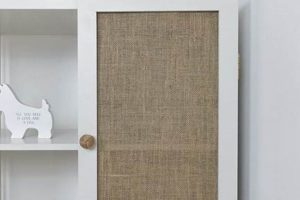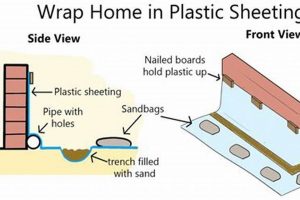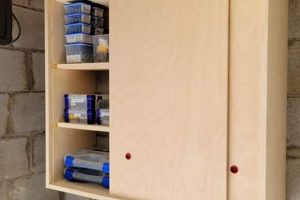The process involves enhancing or altering the appearance of existing doors within a residence through self-executed projects. These improvements can range from simple painting to more involved modifications such as adding panels, changing hardware, or applying decorative finishes. For example, a homeowner might refresh a solid-core door by sanding, priming, and applying a new coat of paint, or introduce a modern touch by installing new door handles and hinges.
Such endeavors offer a cost-effective alternative to complete door replacement, providing an opportunity to personalize living spaces and increase property value. Historically, altering existing doors has been a common practice for homeowners seeking to update interiors without incurring significant expenses. This approach promotes resourcefulness and allows for creative expression tailored to individual aesthetic preferences.
Subsequent sections will explore various techniques, material selection considerations, and safety precautions associated with undertaking modifications. Detailed guidance will be provided on surface preparation, painting methods, hardware installation, and the application of decorative elements, empowering readers to successfully implement their own home improvements.
Practical Considerations for Interior Door Enhancement
The following recommendations aim to provide practical guidance for effectively updating interior doors. Careful planning and execution are essential for achieving desired results.
Tip 1: Thorough surface preparation is paramount. Remove existing hardware, clean the door with a degreaser, and sand the surface to promote proper adhesion of new finishes.
Tip 2: Invest in high-quality paint and application tools. Opt for durable, washable paint formulated for interior use. Employ brushes, rollers, or sprayers appropriate for the chosen paint type.
Tip 3: Consider adding decorative molding or panels to elevate the door’s aesthetic appeal. Measure accurately and use appropriate adhesives and fasteners for secure attachment.
Tip 4: Update door hardware to complement the door’s new style. Ensure proper alignment and secure installation of handles, knobs, and hinges.
Tip 5: Pay attention to edges and corners. Achieve clean lines and smooth finishes through careful application and the use of painter’s tape.
Tip 6: Prioritize safety. Wear appropriate protective gear, such as gloves and respirators, when sanding, painting, or working with adhesives.
Tip 7: Allow sufficient drying time between coats of paint or finish. Rushing the process can result in uneven surfaces and compromised durability.
Adhering to these guidelines contributes to a professional and long-lasting finished product, enhancing the overall aesthetic of the interior space.
The subsequent section will offer insights into common challenges and troubleshooting techniques encountered during the enhancement process.
1. Surface Preparation
Surface preparation represents a foundational stage within the process of altering interior doors. Its effectiveness directly influences the adhesion, appearance, and longevity of any subsequent coatings or treatments applied. Inadequate preparation invariably leads to compromised results, such as peeling paint, uneven finishes, and premature deterioration. For example, neglecting to remove grease or grime from a door’s surface before painting will prevent the paint from properly bonding, resulting in blisters or flaking over time. The act of sanding, filling in gaps, and priming, ensures a smooth, level surface for the paint to adhere, resulting in a professional finish.
Consider the practical implications of neglecting proper sanding on a previously glossed door. The new paint or coating will struggle to adhere to the slick surface, significantly reducing the long term lifespan of the applied finish. Surface preparation includes tasks such as removing old paint, repairing imperfections, cleaning the surface, and applying primer. The selection of specific preparation techniques should be determined by the door’s existing condition and the intended finish. For instance, a door with multiple layers of failing paint may require a more aggressive stripping process, while a door with minor imperfections may only necessitate light sanding and patching.
In summary, Surface Preparation is not simply a preliminary step; it is an integral element in achieving a successful and lasting door alteration. By thoroughly preparing the surface, the longevity, the quality, and the aesthetic goals of the project are greatly increased. Failing to properly address this crucial stage invariably leads to wasted time, increased expense, and less-than-desirable outcomes.
2. Material Selection
Material selection critically influences the outcome of any interior door enhancement project. The choice of materials directly affects the door’s aesthetic appeal, durability, and overall performance. For instance, selecting a low-quality paint will likely result in a less vibrant color, reduced resistance to wear and tear, and a shorter lifespan, ultimately diminishing the success of the effort. Similarly, choosing inappropriate wood filler can lead to cracking or shrinkage, compromising the smoothness of the finished surface and aesthetic appeal.
The connection between material selection and overall success is readily apparent in scenarios involving different door types. Applying oil-based paint to a latex-primed surface, or using a water-based product on an oil-based foundation, results in inadequate adhesion and increased risk of peeling or bubbling. Utilizing unsuitable adhesives for attaching decorative molding can lead to detachment and structural instability. Careful consideration must be given to the compatibility of materials to guarantee the long-term success of the alteration process.
Therefore, a thorough evaluation of material properties and their suitability for specific applications is essential. This includes assessing paint types, wood fillers, adhesives, hardware finishes, and any decorative elements. By prioritizing informed material selection, the end result will be a aesthetically pleasing and practical end result. Furthermore, neglecting this critical aspect will negatively impact the overall project and cost more in the long run.
3. Hardware Updates
Hardware updates are an integral component within the broader scope of interior door alterations. These modifications, involving the replacement or enhancement of functional and aesthetic door components, contribute significantly to the overall impact and perceived value of the transformation.
- Aesthetic Enhancement
Changing door handles, knobs, and hinges offers an immediate and noticeable visual impact. The selection of modern, vintage, or ornate hardware styles can drastically alter the door’s appearance, complementing the door’s color, finish, and overall interior design theme. Replacing outdated brass knobs with sleek, brushed nickel levers, for example, can inject a contemporary feel into a room.
- Improved Functionality
Beyond aesthetics, hardware updates can address functional issues. Worn-out hinges can cause doors to sag or stick, impeding smooth operation. Replacing these hinges with sturdier, higher-quality alternatives resolves these problems and improves the door’s overall performance. Installing new strike plates also helps with a better latching of the door.
- Security Considerations
Hardware upgrades can also enhance security. Replacing a standard latch with a more robust deadbolt provides an added layer of protection. Furthermore, installing reinforced strike plates strengthens the door frame, making it more resistant to forced entry. Upgrading hinges with security screws also makes it harder for intruders to remove the door from its frame.
- Style Consistency
Consistent hardware throughout a home contributes to a cohesive and polished aesthetic. Uniformity in door handle styles, finishes, and designs across different rooms creates a sense of order and visual harmony. This can be particularly important in homes with open floor plans or interconnected spaces, where hardware choices are easily visible from multiple vantage points.
In summary, hardware updates are not merely superficial changes; they represent a crucial element in optimizing both the aesthetic and functional attributes of interior doors. These modifications contribute significantly to the overall success of a DIY project, impacting the visual appeal, operational efficiency, and security of the door within its residential setting.
4. Design Implementation
Design implementation within the context of interior door alteration encompasses the practical application of aesthetic and functional concepts to modify existing doors. It is the process through which a vision or plan is translated into tangible changes, dictating the final appearance and utility of the refurbished element. The success of any door transformation hinges on the effectiveness of design implementation; poor execution can negate the benefits of even the most innovative design ideas. For example, a homeowner may envision a minimalist door featuring a specific shade of gray and sleek, modern hardware. The design implementation phase then entails selecting the appropriate paint, applying it flawlessly, and precisely installing the chosen hardware to realize that vision. A misstep in any of these steps would result in a door that does not meet the intended aesthetic goals.
Effective design implementation requires a careful consideration of several factors, including color palettes, material compatibility, architectural style, and user needs. A modern door with geometric designs, for instance, would be incongruous in a home with a traditional Victorian aesthetic. Similarly, the choice of color should complement the surrounding decor to create a harmonious visual effect. Moreover, modifications should address functional needs; adding a window to an interior door can increase natural light in a dark hallway. Consider a design that increases natural light, enhancing the room. The execution requires precise cuts, proper sealing, and appropriate glazing to ensure the new window functions as intended and contributes to the door’s overall design.
In conclusion, design implementation serves as the critical link between conceptual planning and tangible results in the realm of interior door transformations. A thorough understanding of design principles, attention to detail, and skillful execution are paramount to achieving successful outcomes. The absence of effective design implementation will compromise the overall outcome, leading to dissatisfaction. Therefore, careful planning and skilled execution are essential for realizing successful and aesthetically pleasing door enhancements.
5. Protective Finishing
Protective finishing represents a critical phase in any alteration, directly impacting the longevity and aesthetic appeal of the project. Its application provides a barrier against environmental factors, physical wear, and chemical damage, thereby preserving the underlying materials and prolonging the life. In the absence of a protective layer, surfaces are susceptible to scratches, moisture penetration, fading, and staining. For instance, an interior door, newly painted without the application of varnish or sealant, risks chipping, discoloration, and water damage from routine cleaning or accidental spills. Proper application of a protective finish mitigates these risks, ensuring the door maintains its appearance and structural integrity over time. The lack of attention here has negative consequences to the time and effort.
The practical significance of protective finishes is evident in the diverse range of available products, each tailored to specific needs. Polyurethane coatings offer exceptional durability and resistance to abrasion, rendering them suitable for high-traffic areas. Varnishes provide a clear, hard finish that enhances the natural beauty of wood while offering protection against scratches and moisture. Lacquers offer a smooth, fast-drying finish that is resistant to chemicals and solvents. The selection of an appropriate protective finish hinges on the intended use, the type of material being treated, and the desired aesthetic outcome. Doors need to protect against wear and tear.
In conclusion, protective finishing should be considered an indispensable step in any alterations. It acts as a final layer to safeguard previous work, enhancing durability and preserving aesthetics over prolonged periods. Although often perceived as optional, protective finishing greatly contributes to the project and mitigates potential future maintenance expenses. Ignoring this final step not only compromises initial efforts but can also require more frequent and costly renovations in the long term.
Frequently Asked Questions
This section addresses common inquiries and misconceptions associated with enhancing existing doors, providing clarification on various aspects of the process.
Question 1: Is preparation necessary before commencing any alteration?
Surface preparation is crucial for ensuring proper adhesion of coatings and achieving a durable, aesthetically pleasing finish. Failure to adequately prepare surfaces may result in peeling, chipping, or uneven coverage.
Question 2: What types of paint are suitable for enhancing interior doors?
Both latex and oil-based paints are viable options, each with distinct advantages and disadvantages. Latex paints offer ease of application and cleanup, while oil-based paints provide enhanced durability and a smoother finish. The selection should be based on project requirements.
Question 3: Can altering the appearance of doors increase property value?
Well-executed modifications can contribute to an increase in property value by improving the overall aesthetic appeal of the interior space. Attention to detail and the use of quality materials are essential for maximizing the impact.
Question 4: What tools are essential for a successful project?
Essential tools include sandpaper, brushes, rollers, paint trays, painter’s tape, screwdrivers, and potentially a power sander or sprayer. The specific tools required will depend on the scope and complexity of the project.
Question 5: Is it possible to add decorative elements to existing doors?
The addition of decorative moldings, panels, or other embellishments is a viable method for enhancing the aesthetic appeal of existing doors. Proper installation techniques and appropriate adhesives are necessary for ensuring secure attachment.
Question 6: How can the longevity of be increased?
The longevity can be extended through proper surface preparation, the use of high-quality materials, and the application of a protective topcoat. Regular cleaning and maintenance are also essential for preserving the finish.
In summary, alterations present a cost-effective and customizable approach to improving the aesthetics and functionality of interior spaces. Adherence to proper techniques and careful attention to detail are essential for achieving successful and lasting results.
The following section will provide a concise conclusion, summarizing key takeaways and offering recommendations for further exploration of techniques and resources.
Conclusion
The preceding discussion has thoroughly examined the various facets of enhancement within a residential setting. Key points include the importance of meticulous surface preparation, judicious material selection, strategic hardware updates, thoughtful design implementation, and the application of appropriate protective finishes. Each of these stages contributes significantly to the success and longevity of door alteration endeavors.
Successful projects require careful planning, precise execution, and a commitment to quality. Homeowners undertaking these modifications are encouraged to consult additional resources, seek expert advice when necessary, and prioritize safety throughout the process. The transformative potential of rejuvenated doors underscores the value of thoughtful improvement projects in elevating the overall aesthetic and functional aspects of living spaces.







